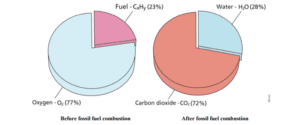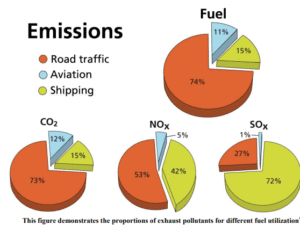Pollution – Impact of Fossil-Fuels
Introduction
The current rise of industrialization has increased the demand for energy. Most direct energy used in industries is extracted from fossil fuels. Most of the global air pollution comes from the combustion of fossil fuels such as diesel fuel, coal, natural gas, oil, and gasoline to provide energy for the production of electricity, transportation, and running machines in industries. Globally, fossil fuels represent 82% of the overall primary energy supply. In the United States, natural gas, oil, and coal represent 815 of the current use of fuel. Energy-related combustion of fuels in middle and high-income countries and burning biomass in low-income countries represent most of the air pollution, thus contributing to 85% of air pollution and a high percentage of carbon dioxide emissions in the air. The burning of fossil fuels also emits Sulphur and nitrogen dioxide, polycyclic aromatic hydrocarbons, black carbon, volatile chemicals, and mercury that contribute to ground-level ozone. The use, processing, and extraction of fossil fuels also have a major impact on natural and environmental resources, including water. The rising recognition of the severe risk to ground and surface water quality from gas fracking operations in the production of natural gas also raises pollution questions. The prevalence of water and air pollution caused by fossil fuels, therefore, poses a significant threat to the environment, hence creating a need to find a solution to prevent or reduce pollution because we still need to rely on fossil fuels to meet energy needs due to the rapid rise of industries in different sectors and the important role of industries in economic growth.
Problem
According to Appannagari (2017), environmental pollution occurs when the environment is exposed to harmful activities. The connection between fossil fuels and pollution has been studied in recent years because of the prevalence in the production of fossil fuels. For instance, many vehicles and heavy machines in different industries across the world rely on fuel. Fossil fuel combustion is mainly identified as a major source of air pollution due to the release of toxins such as volatile organic compounds, particulates, and carbon monoxide. Air pollution is the leading cause of diseases associated with pollution. According to Glencross et al. (2020), air pollution has a major impact on the human immune system. The small-scale burning of solids has made it hard to maintain clean air with simple, affordable devices. Coal also contains Sulphur, trace metals, ash, and other contaminants that contribute to the burden of handling emissions, hence releasing nitrogen oxides, airborne pollutants, and carbon dioxide. Fossil fuel combustion has, therefore, had many indirect and direct impacts on atmospheric processes and composition.
The extraction of fossil fuels has also been attributed to water pollution. Most water bodies near fossil extracting sites may become contaminated by liquid or solid waste created during mining (Allen et al., 2012). The drilling of fossil fuels also brings different materials to the ground, and some of these materials are washed away to water bodies. The extraction of fossil fuels also generates large quantities of waste products or their by-products, thus leading to large-scale challenges in the disposal of waste (Allen et al., 2012). Water that gets to the surface through drilling can also contain traces of metals, dissolved salts, radionuclides, and hydrocarbons. Spills arising from the extraction of fossil fuels are also a major cause of water contamination. Such an incident occurred in 2000 when a containment dam failed in Kentucky during coal extraction (Allen et al., 2012). Surface water may also drain into ground openings left after mining, and groundwater regularly accumulates in mines resulting in the possible release and creation of mine waters that are acidic. Such impacts can make water unfit for uses such as human use, supporting ecosystems, and, in some instances, environmental degradation. The production of natural gas has also had a significant impact on water pollution by reducing the quality of water, particularly at the extraction phase through combustion and processing. The extraction of natural gas can also produce large volumes of water contaminated by heavy metals, hydrocarbon residues, boron and hydrogen sulfide, and high levels of salt concentration. According to Ahmed & Ismail (2018), toxins and heavy metals in industrial waste are the main cause of suppression of the human immune system. The extraction of natural gas also contributes to more than 50% of the water produced in fossil fuel production as petroleum extraction. This water finds its way to nearby water bodies (Allen et al., 2012). Currently, preventing water pollution arising from the extraction of fossil fuels has been hard because most of these water pollutions take time to be identified, particularly if the pollution occurs in groundwater.
Solutions
According to Perera (2018), one of the solutions to fossil fuel pollution is using clean technologies that reduce the emission of smoke. Clean technologies can also be used to capture methane emitted in the extraction of fossil fuels and use it to create biogas instead of releasing it to the environment. This will help avoid deaths related to air pollution while also reducing the costs incurred in the importation of fossil fuels. Countries can also set fuel-economy measures for emissions from vehicles, set limits for power plants, and set strict energy codes that are more efficient. The second solution is moving to clean energy generation modes and prioritizing rapid urban transportation, cycling, and walking networks in cities and passenger-level and rail inter-urban freight, moving from vehicles using a lot of diesel to low-emission vehicles, including the use of fuels emitting low Sulphur(Perera,2018). The third solution is improving buildings’ energy efficiency and transforming the structure of cities to make them more compact because that would make them energy efficient. The fourth solution is increasing the use of renewable combustion-free sources of energy, low-emission fuels, using the distributed generation of energy, and co-generation of power and heat. Various alternative energy sources should also be considered to replace the use of fossil fuels. In the 21st century, biofuels such as corn ethanol and biodiesel have been widely promoted by high-level government regulations and policies in various countries. Alternative fuel policies should also be used to ensure that industries are serious about using renewable energy (Perera,2018). For instance, the Hydrogen Economy policy has been implemented by the United States government to reduce the country’s reliance on imported oil. Alternative energy sources such as wind and sun should also be considered to produce energy to be used for running machines instead of relying on oil and diesel.
Evaluation of Evidence
Soot from the combustion of fossil fuels is considered significantly vital because of its small particles and accumulation in human lung tissues before it moves to different body organs. Other toxins from during the combustion of diesel. Other harmful gases are also emitted from fossil fuels before burning. Pollution accidents also occur involving fossil diesel and are hard to contain. Small amounts can also result in the open sea and coastal pollution. Fossil diesel is also degraded for a long time hence requiring precautionary measures during its transportation on both sea and land. Burning fossil fuels also includes various technical chemical processes. Bernodusson (2018) argues that under normal conditions,1 kg of fuel is burned with air approximately weighted at 14 kg. The air contains oxygen levels of kg. The ratio for burning fuel is, therefore, 77 percent oxygen and 23 percent, as shown in the image below.
(Source: Bernodusson, 2018)
The burning of fossil fuels under normal conditions produces 3.18 kg of carbon dioxide and approximately 1.25 kgs of water. The combustion ratio is 72 percent carbon dioxide and 28 percent water. Generally, it can be assumed that the minimum amount of carbon dioxide produced in burning fuels is 3.15 kg while the maximum amount is 3.18 kg because other compounds in the fuel do not have a significant impact on carbon dioxide formation. Diesel engines also run use fossil oils with high levels of cetane hence contributing to high pollution levels. The burning of fossil fuels for vessels can also be divided into marine diesel oils and heavy fuel oil. Heavy fuel oil covers heavy fuels, while marine diesel oil incorporates the use of light marine diesel, gas, and marine diesel oils (Bernodusson, 2018). The density of heavy fuel oils is higher compared to diesel oils. An image of the impact of fossil fuels on carbon dioxide levels is shown below.
(Source: Bernodusson, 2018)
According to Bernodusson (2018), hydrogen sulfide is also emitted during the evaporation of oil with Sulphur as one of its components. Inhaling Sulphur is dangerous, and it can harm the human breathing system and is additionally highly explosive. The combustion of fossil fuels also emits carbon monoxide, which arises from insufficient burning time or the concentration of the mix of oil in the burning chamber.
Ethical Outcomes of Solution
The main ethical outcome of using clean energy policies and renewable energy provides equity for vulnerable and developing countries for reducing and stabilizing the number of pollutants in the air hence protecting people from diseases caused by air pollution. Clean energy policies and the use of renewable energy also enhance sustainability, thus protecting future generations through the conservation of the environment by preventing pollution by reducing emissions and providing more opportunities for fostering the principle of equity in vulnerable and developing countries (Dernbach & Brown, 2009). Enacting policies regulation pollution arising from burning fossil fuels also creates accountability, ensuring that companies accused of ruining public health due to the drilling of fossil fuels compensate those affected and stop their operations to avoid harming more lives.
Despite the positive ethical outcomes associated with the use of renewable energy, there are various ethical challenges that create a negative outcome. To begin with, the cost of producing renewable energy is high compared to that of producing fossil fuels (Yildizbasi, 2021). In most instances, private firms are not willing to meet these costs, hence prompting the government to meet them to encourage the use of renewable energy. This places a burden on taxpayers whose money is used to support such projects. The wide-scale use of renewable energy is also only possible among wealthy countries that can comfortably meet the costs associated with the production of renewable energy, hence forcing developing countries to continue relying on harmful sources of energy such as fossil fuels (Urmee et al., 2009). Fairness and equality, therefore, raise a huge concern on whether countries should receive equal pressure to use renewable energy to prevent pollution arising from the use of fossil fuels. Oil-dependent economies will also experience a significant drop in economic growth as a result of the use of renewable energy hence subjecting most citizens to poverty and suffering.
Conclusion
The rise in industrialization has promoted economic growth, especially in developing countries. Most developing countries producing coal and oil also rely on it for economic development, and the citizens employed in the oil and coal mines rely on the job to sustain themselves and their families. This, therefore, creates a dilemma on whether the use of fossil fuels should be prevented or not. Wealthy countries may consider the use of renewable energy as a great solution to prevent pollution because they do not have many fossil fuel mining sites and can also afford the cost of producing renewable energy, while underdeveloped and developing costs may not be in a position to meet these costs and may be forced to strain their citizens by increasing taxes. However, the negative impact of fossil fuels on the environment by polluting water and air cannot be ignored. This is mainly due to the various impacts water and air pollution from fossil fuels have on human health. Governments in developing and underdeveloped countries should, therefore, collaborate with governments in developed countries to get the financial aid required to generate renewable energy. It is also important to consider alternative mining methods to ensure that people who rely on coal and oil mining do not lose their sources of income.
References
Ahmed, S., & Ismail, S. (2018). Water pollution and its sources, effects & management: a case study of Delhi. Shahid Ahmed and Saba Ismail (2018)’ Water Pollution and its Sources, Effects & Management: A Case Study of Delhi’, International Journal of Current Advanced Research.
Appannagari, R. R. (2017). Environmental pollution causes and consequences: a study. North Asian International Research Journal of Social Science and Humanities, 3(8), 151-161.
Allen, L., Cohen, M. J., Abelson, D., & Miller, B. (2012). Fossil fuels and water quality. The World’s Water, 73-96. https://doi.org/10.5822/978-1-59726-228-6_4
Bernodusson, J. (2018). Combustion of Fossil Fuels. Samgöngustofa. https://www.samgongustofa.is/media/siglingar/skyrslur/Combustion-of-fossil-fuels-2018-en-1.pdf
Dernbach, J. C., & Brown, D. A. (2009). The ethical responsibility to reduce energy consumption. SSRN Electronic Journal. https://doi.org/10.2139/ssrn.1464875
Glencross, D. A., Ho, T., Camiña, N., Hawrylowicz, C. M., & Pfeffer, P. E. (2020). Air pollution and its effects on the immune system. Free Radical Biology and Medicine, 151, 56-68. https://doi.org/10.1016/j.freeradbiomed.2020.01.179
Perera, F. (2018). Pollution from fossil-fuel combustion is the leading environmental threat to global pediatric health and equity: Solutions exist. International Journal of Environmental Research and Public Health, 15(1), 16. https://doi.org/10.3390/ijerph15010016
Urmee, T., Harries, D., & Schlapfer, A. (2009). Issues related to rural electrification using renewable energy in developing countries of Asia and Pacific. Renewable Energy, 34(2), 354-357. https://doi.org/10.1016/j.renene.2008.05.004
Yildizbasi, A. (2021). Blockchain and renewable energy: Integration challenges in circular economy era. Renewable Energy, 176, 183-197. https://doi.org/10.1016/j.renene.2021.05.053
ORDER A PLAGIARISM-FREE PAPER HERE
We’ll write everything from scratch
Question
Reflect: Based on the topic that you have chosen, you will need to use critical thinking skills to thoroughly understand how this topic can be a global societal problem and determine some logical solutions to the problem.

Pollution – Impact of Fossil-Fuels
Write This Final Paper, an argumentative essay, will present research relating the critical thinker to the modern, globalized world. In this assignment, you need to address the items below in separate sections with new headings for each.
In your paper,
Identify the global societal problem within the introductory paragraph.
Conclude with a thesis statement that states your proposed solutions to the problem. (For guidance on how to construct a good introduction paragraph, please review the Introductions & Conclusions (Links to an external site.) from the University of Arizona Global Campus Writing Center (Links to an external site.).)
Describe background information on how that problem developed or came into existence.
Show why this is a societal problem.
Provide perspectives from multiple disciplines or populations so that you fully represent what different parts of society have to say about this issue.
Construct an argument supporting your proposed solutions, considering multiple disciplines or populations so that your solution shows that multiple parts of society will benefit from this solution.
Provide evidence from multiple scholarly sources as evidence that your proposed solution is viable.
Interpret statistical data from at least three peer-reviewed scholarly sources within your argument.
Discuss the validity, reliability, and any biases.
Identify the strengths and weaknesses of these sources, pointing out limitations of current research and attempting to indicate areas for future research. (You may even use visual representations such as graphs or charts to explain statistics from sources.)
Evaluate the ethical outcomes that result from your solution.
Provide at least one positive ethical outcome as well as at least one negative ethical outcome that could result from your solution.
Explain at least two ethical issues related to each of those outcomes. (It is important to consider all of society.)
Develop a conclusion for the last paragraphs of the essay, starting with rephrasing your thesis statement and then presenting the major points of the topic and how they support your argument. (For guidance on how to write a good conclusion paragraph, please review the Introductions & Conclusions (Links to an external site.) from the University of Arizona Global Campus Writing Center (Links to an external site.).)



